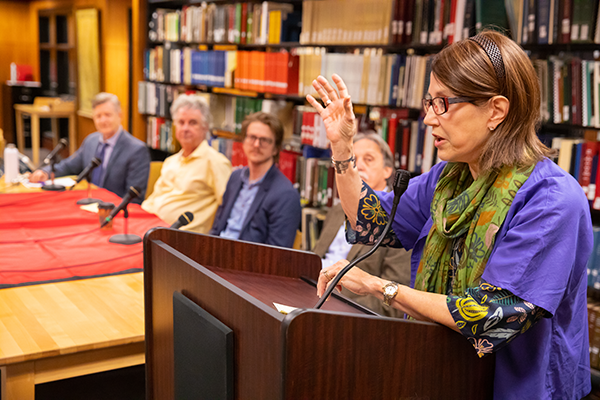When readers of the weekly Lafayette Guide opened their newspapers on Oct. 31, 1963, they learned that men had ordered – and been served – coffee at lunch counters four days earlier.
This seemingly ordinary act had extraordinary implications. On the morning of Monday, Oct. 28, at F.W. Woolworth, Morgan & Lindsey, and McCrory’s department stores, a half dozen men became the first African Americans to receive service at the previously all-white eateries.
“The integration barriers in Lafayette were broken in 30 minutes,” the Guide reported. It was the only media outlet in the city to carry news of the milestone.
The men’s actions were largely symbolic. They had prearranged the event with the stores’ managers.
But Mayor J. Rayburn Bertrand wanted to curtail backlash from white residents and prevent similar actions by African American civil rights advocates at other stores. He secured assurances from the city’s daily newspaper, its two television stations and three radio stations that they would not print or broadcast the story.
Alton E. Broussard, editor and co-owner of the Guide, refused Bertrand’s request. He then revealed the scheme to the weekly’s readers on the same day he published the item about the lunch counter integration.
In an editorial, Broussard wrote that his publication “feels that it has a real and strong obligation to report the news. The public’s right to know is indisputable and fundamental, and the suppression of news is not in the public interest.”
If the Guide differed from its contemporaries, “it is because it had the guts to stand by its convictions,” the editorial concluded.
Broussard published the Guide from May 23, 1962, to July 16, 1964. His family recently donated a bound volume of the newspaper’s entire run to Special Collections at the University of Louisiana at Lafayette.
During a panel discussion in late November marking the acquisition, Special Collections director Zachary Stein said Broussard “believed in the traditional ethics of journalism – that the who, when, what, where and how were what made a true and factual news story.”
Broussard conveyed those fundamentals to students at Southwestern Louisiana Institute and the University of Southwestern Louisiana, both precursors to UL Lafayette. His career at SLI began in 1947 as director of public relations. He taught journalism as well. Broussard retired in 1975 and died in 1983.
Mary Perrin, Broussard’s daughter, said editing the Guide augmented her father’s salary and helped support three children. The newspaper also gave him an opportunity to experiment. “It wasn’t just the writing and the journalism he was interested in. He was interested in the actual production of the newspaper,” she said.
The Guide was produced using cold type. Most newspaper publishers in the 1960s used labor- and time-intensive linotype machines that set text line by line on metal strips.
By contrast, cold type enabled typesetters to compose stories on regular typewriters, paste the justified columns onto pages, which were then photographed alongside advertising and images. Those photographs were transferred to plates, which when inked and mounted on press cylinders, reproduced the pages on newsprint.
The ease of production enabled Broussard’s family to help publish the Guide. Perrin made circulation calls and pasted up pages alongside her father in a makeshift composing room in the family’s Duclos Street garage. Her mother typed stories.
By its second year, the Guide had a small advertising and editorial staff and a battalion of school-age carriers who distributed its 6,500 copies in the city’s southside. By August 1963, the newspaper had expanded its circulation area citywide. By the time the Guide folded a year later, it boasted the largest circulation of any weekly in Louisiana – nearly 12,000.
But circulation alone couldn’t keep the paper afloat. Businesses, pressured by management of the city’s daily newspaper, began to decline to advertise in the Guide. The weekly’s July 16, 1964, issue was its last.
The bound volume Broussard’s family donated to Special Collections is available to researchers. Though the years have yellowed its 110 issues, the scrappy weekly has a “timeless” quality, said Dr. Barry Ancelet, professor emeritus of Francophone studies at UL Lafayette. He was on the panel that marked the library’s acquisition of the Guide.
“Very simply, it was excellent, attentive reporting of the sort that we have needed in every time,” Ancelet said.
The Guide published “what you would expect” alongside surprising items readers might not, said Sam Broussard, Alton Broussard’s son. He rattled off a list of topics that included “drainage issues, sewers, lots of police jury meetings, political races, taxation, petroleum, schools, this University.”
“And did you know there was a plague of crickets and stinkbugs on Jefferson Street?” Sam Broussard asked. “No, you didn’t – until the Guide brought it to you.”
Photo caption: Mary Perrin, daughter of Lafayette Guide editor Alton E. Broussard, discusses her father’s newspaper during a Nov. 21 panel discussion at Special Collections. Broussard’s family recently donated a bound volume of the short-lived newspaper to the University. (Photo credit: Doug Dugas / University of Louisiana at Lafayette)
